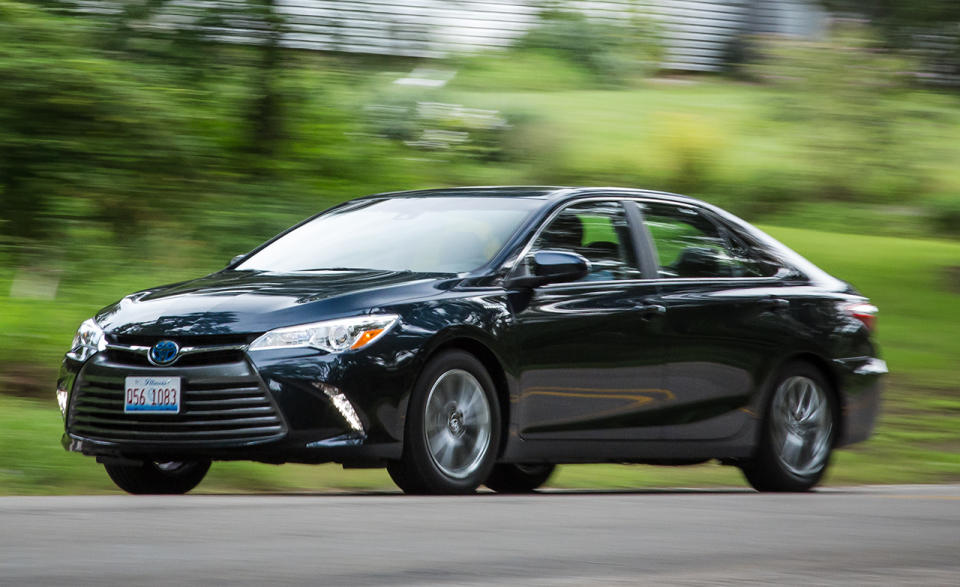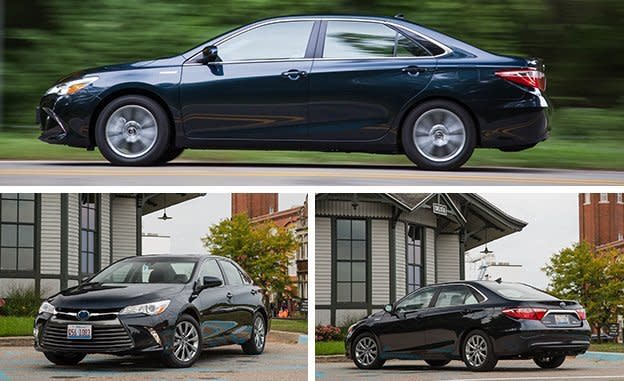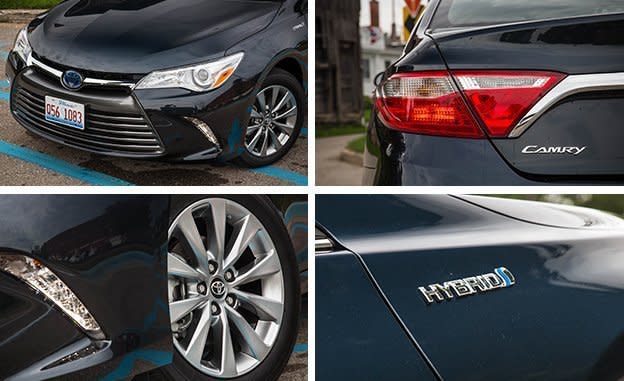2017 Toyota Camry Hybrid

A decade ago, Toyota added a gas-electric hybrid powertrain to its best-selling Camry mid-size sedan. It offered 34 mpg combined, according to the EPA, 10 mpg better than the conventionally powered Camry four-cylinder and with minimal compromise in cargo space or comfort. Other manufacturers quickly joined the hybrid mid-size-sedan class, but few could keep up with the Camry’s straight-A grades in refinement and fuel economy.
The short-lived, V-6–powered 2005–2007 Honda Accord hybrid was too focused on power rather than mpg to contend for green-leaning drivers’ dollars. The 2008–2010 Chevrolet Malibu hybrid was a so-called “mild hybrid” with little mpg benefit at all. Nissan copied the Camry’s homework by licensing some of Toyota’s hybrid tech for the unrefined 2007–2011 Altima hybrid. And—embarrassingly—Hyundai was forced to downgrade its 2011–2012 Sonata hybrid’s 40-mpg rating after the EPA found errors in the company’s fuel-economy test procedures.

For a while, the Ford Fusion hybrid was the only real contender for the Camry hybrid’s honors. But lately, the rest of the class has been aggressively making up for lost time. Chevrolet and Honda have skipped a grade with the latest Accord and Malibu hybrids, both of which use comparatively innovative gas-electric powertrains.
Toyota Tech Getting Stale?
The Camry received extensive updates for 2015, but none of the changes applied to the hybrid drivetrain, which remains a 2.5-liter Atkinson-cycle four-cylinder paired with a 141-hp electric motor powered by a nickel-metal-hydride battery pack; there’s a second motor/generator that determines the drive ratio between the engine and the differential. This is the hybrid setup that Toyota has been using for years, and it has proved to be reliable and durable— for proof, look no further than the many Camry hybrid taxicabs in New York City.
And yet it’s not hard to figure out why the Camry hybrid’s EPA mileage ratings of 40/37 mpg city/highway for the XE and SLE (the more spartan LE trim, with its narrower tires, achieves 42/38 mpg) are now a bit behind the curve. The 2017 Honda Accord hybrid and 2017 Chevrolet Malibu hybrid use more powerful electric motors and lighter, more efficient lithium-ion batteries. Their EPA ratings soar beyond the Camry’s, with the Honda at 49/47 mpg and the Chevy at 49/43 mpg.

MPG on the Open Road
Our own observed fuel-economy numbers tell a slightly different story. The Camry is still behind the Accord and the Malibu in the real world, but not by as much as the EPA might suggest. The Camry achieved 34 mpg overall in our hands, 1 mpg short of our results with both the 2017 Accord hybrid and the 2016 Malibu hybrid. The Toyota also overachieved in a 200-mile highway fuel-economy test, recording a 42-mpg average at 75 mph that beats its EPA highway rating by a whole 5 mpg. The Accord hybrid did even better in our real-world highway test, at 45 mpg, but the EPA ratings may overstate the real gap between the Camry hybrid and its competition.
Acceleration numbers for the Toyota, the Chevrolet, and the Honda hybrids are close, with the Camry hybrid matching the Accord hybrid’s zero-to-60-mph time of 7.2 seconds. (The Malibu is 0.2 second slower.) The Camry is relatively responsive to jabs from your right foot, with the electric motor providing a nice midrange torque boost for passing. It’s a useful power uptick over the standard Camry’s unassisted 2.5-liter four-cylinder, which was 0.8 second slower to 60 mph in our testing.
But the Camry was subpar in our handling evaluation, where it gripped the skidpad at 0.79 g, against the Malibu’s 0.84 g and the Accord’s 0.81. Even relatively sedate drivers will notice the low grip threshold of the Toyota’s Michelin Primacy tires on the road—it takes only a bit of pushing, such as a spirited run at a highway entrance ramp, to squeal the Camry’s tires.

Passing Grade
Our Camry SE test car, marketed as a “sporty” trim level, also suffered from questionable suspension and steering tuning. (We photographed an XLE for this story.) Its steering rack feels heavily weighted, perhaps because Toyota thinks this helps convey sportiness, but its lack of feedback means that it is vague and disconnected from the road. The dampers are noticeably stiffer than in other, non-SE Camrys we’ve driven, but this serves to harm the car’s ride quality without lessening body roll or improving composure over bumps. Both the Accord hybrid and the Malibu hybrid control body motions better and feel tighter overall.
The standard Camry has lagged behind its competition dynamically for a while. But against its previously lackluster hybrid competitors, the Camry could cruise along on the assets of its gas-electric powertrain and resulting high mpg numbers. That’s not so anymore. Honda and Chevrolet have surpassed the Camry hybrid in technology, fuel economy, and driving pleasure. Toyota may still earn a passing grade, but it’s no longer the de facto valedictorian of the hybrid mid-size-sedan classroom.
Specifications >
VEHICLE TYPE: front-engine, front-wheel-drive, 5-passenger, 4-door sedan
PRICE AS TESTED: $29,605 (base price: $27,625)
ENGINE TYPE: DOHC 16-valve Atkinson-cycle 2.5-liter inline-4, 156 hp, 156 lb-ft; permanent-magnet synchronous AC electric motor, 141 hp, 199 lb-ft; combined power rating, 200 hp; 1.6-kWh nickel-metal-hydride battery pack
TRANSMISSION: continuously variable automatic
DIMENSIONS:
Wheelbase: 109.3 in
Length: 190.9 in
Width: 71.7 in Height: 57.9 in
Passenger volume: 102 cu ft
Cargo volume: 13 cu ft
Curb weight: 3516 lb
C/D TEST RESULTS:
Zero to 60 mph: 7.2 sec
Zero to 100 mph: 18.8 sec
Zero to 110 mph: 23.8 sec
Rolling start, 5–60 mph: 7.5 sec
Top gear, 30–50 mph: 3.6 sec
Top gear, 50–70 mph: 4.9 sec
Standing ¼-mile: 15.6 sec @ 92 mph
Top speed (governor limited): 117 mph
Braking, 70–0 mph: 188 ft
Roadholding, 300-ft-dia skidpad: 0.79 g
FUEL ECONOMY:
EPA city/highway driving: 40/37 mpg
C/D observed: 31 mpg
C/D observed highway driving: 42 mpg
C/D observed highway range: 710 miles

 Yahoo Autos
Yahoo Autos 